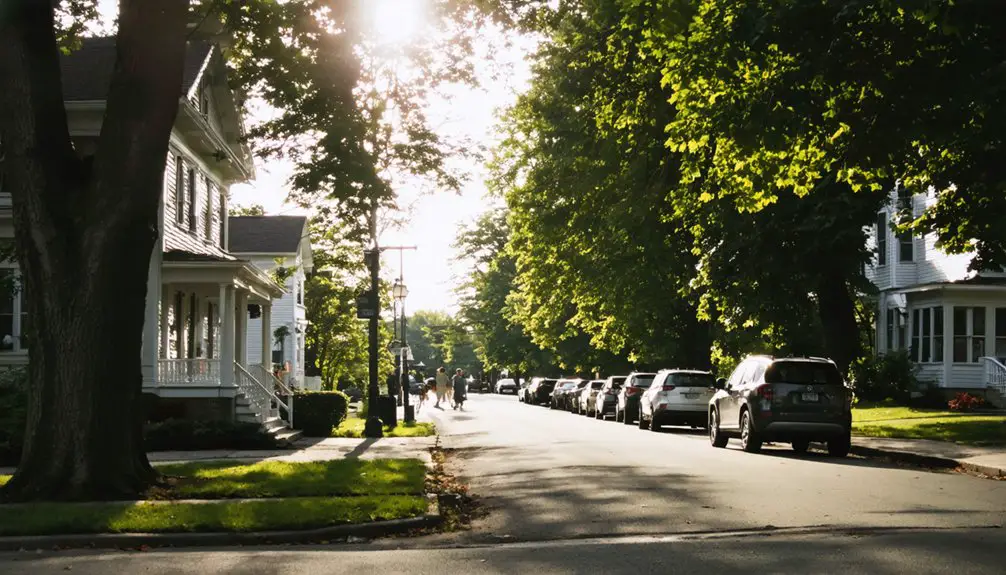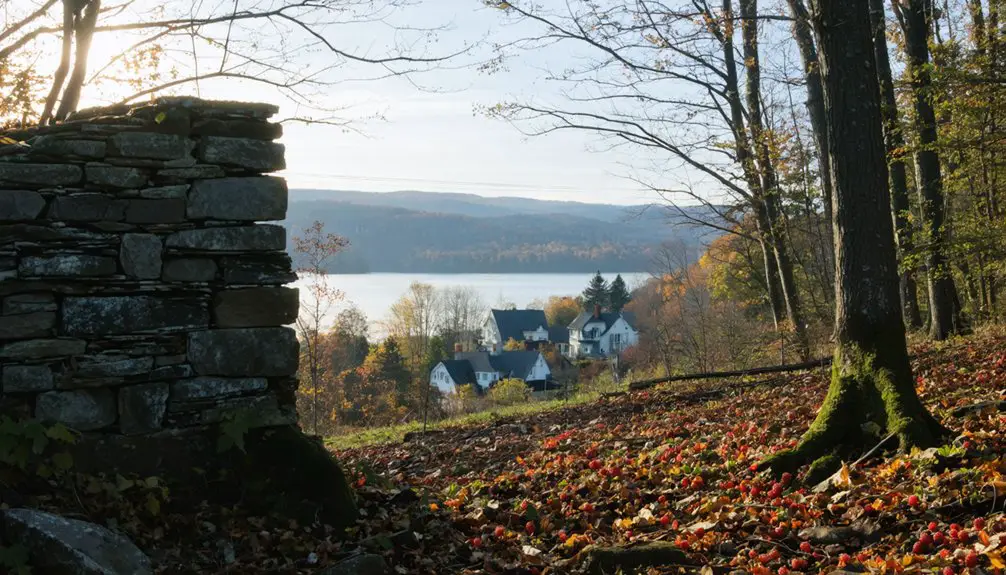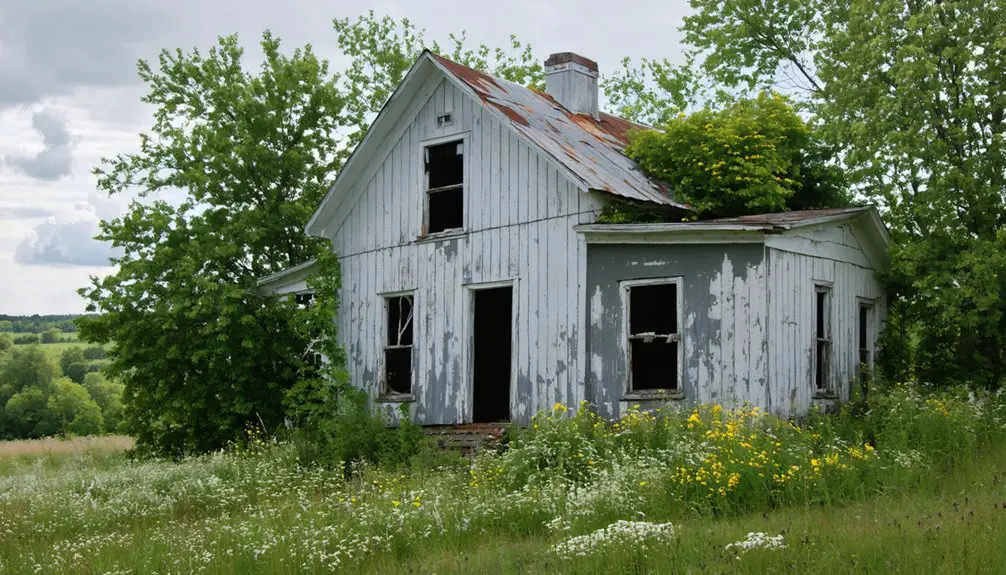You won’t find a ghost town in Colchester, Vermont – it’s actually one of the state’s longest continuously inhabited settlements since 1791. While the town briefly emptied during the Revolutionary War (1776-1783), settlers quickly returned to establish a thriving community. Today’s Colchester features historic landmarks like Fort Ethan Allen and the relocated Colchester Reef Lighthouse. The town’s only “ghosts” exist in local paranormal tales, particularly around St. Michael’s College, where a rich supernatural history awaits investigation.
Key Takeaways
- Colchester experienced a brief period as a ghost town during 1776-1783 when settlers fled British threats during the Revolutionary War.
- Historical maps document 70 detailed locations of ghost town sites and trails throughout Colchester’s evolution.
- Captain Mallet, according to local lore, remained behind when others fled, contributing to the town’s haunted history.
- The town’s abandonment was temporary, with settlers returning after the Revolutionary War to rebuild under Ira Allen’s leadership.
- Early farming settlements around Mallet’s Bay and Colchester Point were completely deserted during the war period.
The Truth About Colchester’s Settlement Status
While some local legends have incorrectly labeled Colchester, Vermont as a ghost town, historical records definitively prove it’s been a continuously active settlement since its official organization in 1791.
The town’s settlement patterns show only one brief interruption during the Revolutionary War, after which residents promptly returned to rebuild their community.
Early inhabitants discovered evidence of previous occupation through ancient fortifications and artifacts found at Colchester Point.
You’ll find evidence of community continuity in the unbroken chain of town meetings since 1793, supported by a valid charter from 1763.
Despite natural constraints like Colchester Bog limiting some development, the town has maintained steady growth and governance.
From Ira Allen’s early mills to modern infrastructure projects, Colchester’s vibrant history demonstrates it’s anything but abandoned, with active municipal operations continuing to this day.
The area’s economic vitality is evident through numerous established businesses, including W. Macrae’s furniture business which began operations in 1883.
Historical Development Along Lake Champlain
As you explore Lake Champlain’s early maritime history, you’ll find that Samuel de Champlain’s 1609 discovery established vital trade routes connecting the St. Lawrence and Hudson Rivers.
The lake’s strategic importance sparked intense competition between French and English interests, leading to the construction of fortifications and early European settlements along its shores in the 17th century. The technological advancements in steamship travel transformed Lake Champlain into a competitive waterway during the 19th century.
Maritime commerce flourished as settlers developed Colchester’s waterfront, with lighthouses later becoming essential navigational aids for ships traversing these historic trading routes.
Maritime Trade Routes
Once Lake Champlain’s potential for connecting major waterways became apparent, it evolved into an essential 450-mile international maritime route linking Québec to New York City by the mid-19th century.
You’ll find that maritime innovations transformed the lake’s trade dynamics, particularly with the introduction of sailing canal boats designed to navigate both open waters and narrow canals with adjustable sails. By 1833, 232 canal boats were registered for cargo and passenger transport.
The completion of the Champlain Canal in 1823 revolutionized regional commerce, connecting the lake to New York’s extensive canal system and the Atlantic Ocean.
You’d have seen vessels carrying iron from the Adirondacks, lumber from surrounding forests, and agricultural products from shoreline communities. Ships were built using local timber resources from eastern Adirondack forests.
The addition of steam tugboats further enhanced cargo movement, while the shift to iron and steel vessels in the 1920s marked a new era in Lake Champlain’s maritime history.
Early Settlement Patterns
When Colchester, Vermont received its charter in 1763, prominent figures Ira Allen, Ethan Allen, and Remember Baker spearheaded the initial settlement efforts along Lake Champlain.
Early farming practices centered around Mallet’s Bay and Colchester Point, where pioneers like Abel Hulburt and Abel Benedict established the first farms by 1775.
You’ll find that settlement challenges arose during the Revolutionary War, forcing most residents to abandon their homesteads between 1776 and 1783.
After the war, settlers returned with renewed determination, and Ira Allen built vital infrastructure including sawmills and forges.
The fertile Champlain Valley, with its pitch pine forests and abundant streams, attracted families from southern New England.
They strategically positioned their farms along waterways, creating a stable rural community that would shape Colchester’s development for generations.
The Western Abenaki people had long established settlements in the region, utilizing the area’s abundant wild plant foods before European colonization.
The strategic placement of lighthouses along Lake Champlain transformed maritime navigation in the mid-19th century, with the Crown Point Light of 1858 marking a pivotal development in the region’s maritime infrastructure.
You’ll find that before lighthouse automation took hold, dedicated keepers maintained these essential maritime signaling stations, guiding vessels through treacherous passages laden with iron ore and lumber cargo. The 55-foot tower provided crucial navigational aid to passing ships.
Crown Point’s evolution mirrors the lake’s changing role, particularly its 1912 transformation into a memorial commemorating Champlain’s explorations. The States of New York and Vermont collaborated on this significant commemorative project.
The original stone octagonal tower, built by Ellis and O’Neil, gave way to a classical design featuring Doric columns and Rodin’s sculptural contributions.
While modern navigation relies less on these beacons, they’ve left an indelible mark on Lake Champlain’s maritime heritage, standing as representations of the region’s nautical past.
Maritime Heritage and the Lighthouse Legacy
You’ll find the original lightkeeper’s demanding daily routines at Colchester Reef Lighthouse reflected the isolation and challenges of maintaining this critical beacon along Lake Champlain’s bustling 19th-century trade route.
While ships transported lumber, minerals, and agricultural goods between New York and Vermont ports, the lighthouse keeper maintained the Fresnel lens, recorded weather data, and assisted vessels in distress through harsh conditions. The 55-foot wooden tower served as both a navigational aid and living quarters for the dedicated keepers who called it home. Keeper August Lorenz endured treacherous winters for over two decades, including an incident where an ice floe crashed through the kitchen.
When modern GPS and radar systems made the lighthouse obsolete by the mid-20th century, the historic structure was relocated to Shelburne Museum, where it stands as a tribute to Lake Champlain’s maritime past.
Lighthouse Keeper’s Daily Life
Living atop Colchester Reef’s solitary outpost, lighthouse keepers maintained a rigorous daily schedule that revolved around their sacred duty of safeguarding maritime traffic.
You’d find these dedicated souls performing meticulous lighthouse maintenance practices, from polishing the essential Fresnel lens to trimming lamp wicks for ideal illumination.
Despite the emotional challenges of isolation, keepers like August Lorenz embraced their solitary lifestyle, finding purpose in their significant role.
- Each morning began with detailed inspections of the light and fog signals.
- Afternoons involved structural repairs, painting, and maintaining detailed logbooks.
- Evening brought the most critical task: ensuring the light burned bright through the darkness.
Life in the two-story lighthouse demanded unwavering commitment, even as keepers balanced their duties with family life in their four-bedroom quarters above.
Lake Trade Route History
Long before European settlers arrived, Lake Champlain served as a essential trade artery connecting indigenous communities across the Northeast.
You’ll find evidence of how Native peoples mastered lake navigation, using the frozen waters in winter for sledge transport and the open waters in summer for canoe trade.
As colonial powers emerged, you’d see French and British forces competing for control, building strategic forts like Ticonderoga and Crown Point.
The lake’s significance peaked during the Revolutionary War, culminating in the Battle of Valcour Island.
By 1823, commercial shipping transformed the waterway into a bustling trade route where steamboats like the Phoenix carried passengers and cargo between New York and Quebec.
The construction of Colchester Reef Lighthouse in the 1870s made these waters safer, securing Lake Champlain’s position as a critical economic corridor.
While Lake Champlain’s maritime landscape has evolved dramatically since the 1800s, the Colchester Reef Lighthouse stands as its most prominent abandoned guiding system.
You’ll find its story reflects the broader transformation of maritime technology, from manned stations to automated beacons. After serving as a critical guide for vessels traversing dangerous reefs from 1871 to 1933, this Second Empire structure yielded to modern guidance methods.
- The lighthouse’s fixed red sixth-order Fresnel lens, once visible for 11 miles, gave way to a solar-powered beacon installed in 2006.
- Nine lighthouse keepers maintained this abandoned structure before advancing technology made their roles obsolete.
- Its relocation to Shelburne Museum in 1952 preserved one of Lake Champlain’s most significant abandoned structures, transforming it from a guiding aid to a historical monument.
St. Michael’s College Paranormal Activities
Among Vermont’s most haunted academic institutions, St. Michael’s College harbors a rich history of paranormal activity.
You’ll find ghost sightings concentrated in four main locations: North Campus Chapel, Herrouet Theatre, Joyce Hall Attic, and McCarthy Performance Center.
The most famous spirit is Sister Sarah, a nun who died in the 1950s and still appears in the college’s theatre spaces.
She’s known for moving props and manifesting in audience seats.
In Joyce Hall’s attic, 1960s cult rituals left their mark, with students reporting children’s ghostly giggles and discovering pentagrams.
The chapel holds its own mysteries, including the unexplained 1978 bell incident that preceded a theatre fire.
Paranormal research confirms these locations as notable haunted sites, though the activity tends to be sporadic rather than continuous.
Debunking the Ghost Town Myth

You’ll find that Colchester’s reputation as a ghost town directly contradicts its well-documented history of steady population growth, which has surpassed 17,000 residents in recent counts.
The town’s continuous development since the 1892 establishment of Fort Ethan Allen, including active military installations, university expansions, and preserved historic officer homes on Dalton Drive, demonstrates thriving community life rather than abandonment.
Historical records show Colchester maintains robust civic services, including volunteer fire and rescue operations established in the 1960s, along with numerous community events and activities that firmly establish it as a vibrant, populated Vermont town.
Historical Facts Challenge Myth
Despite popular misconceptions about Colchester being a ghost town, historical records reveal a far different reality. The town’s historical preservation and cultural significance remained intact even during its brief wartime evacuation in 1776.
While most residents fled due to threats from British-allied Native Americans, the town maintained its political representation and quickly rebounded after the Revolutionary War ended in 1783.
Consider these key historical facts that challenge the ghost town myth:
- Capt. Mallet and a few others stayed during the seven-year evacuation period.
- Ira Allen led a robust resettlement effort after 1783, rebuilding mills and forges.
- The establishment of Fort Ethan Allen in 1892 brought sustained military and civilian activity.
You’ll find that Colchester’s temporary wartime depopulation was merely a brief chapter in its otherwise continuous development and growth.
Active Population Since Settlement
Historical census records conclusively demonstrate Colchester’s continuous population growth from its initial 137 residents in 1791 to today’s 17,524 inhabitants.
You’ll find uninterrupted settlement patterns showing steady expansion, from 347 residents in 1800 to 1,489 by 1830, and reaching 3,041 by 1860.
The town’s demographic trends reveal consistent growth supported by diverse economic foundations.
While the Revolutionary War caused a brief pause in settlement between 1776-1783, residents quickly returned and established thriving industries.
From early sheep farming with 4,000 sheep by 1830 to modern institutions like Saint Michael’s College and the Vermont National Guard base, Colchester has maintained an active, growing population.
The town’s strategic location on Lake Champlain and proximity to Burlington continue attracting new residents.
Thriving Modern Community Today
While rumors of Colchester’s abandonment occasionally surface online, modern demographic data thoroughly debunks the “ghost town” narrative.
Today’s Colchester stands as Vermont’s third most populated municipality, with over 17,500 residents driving continued urban development and vibrant community engagement.
- You’ll find a thriving population base with a median age of 37.9 years, balanced age distribution, and growing diversity that includes multiple ethnic groups and backgrounds.
- The town’s robust $97,708 median household income supports local businesses and development, while educational institutions like Saint Michael’s College fuel cultural growth.
- Your access to Lake Champlain, proximity to Burlington’s job market, and strategic location near Vermont National Guard facilities cement Colchester’s position as an integral part of the region’s metropolitan landscape.
Regional Ghost Towns vs. Colchester Today

Unlike typical abandoned settlements throughout New England, Colchester’s brief period as a ghost town during the American Revolution didn’t seal its fate.
While many regional ghost towns remain frozen in time with crumbling structures and eerie folklore, you’ll find Colchester has evolved into a vibrant municipality.
The stark contrast becomes clear when you compare Colchester to other abandoned military installations in the region.
Though Fort Ethan Allen’s empty chapel and Herrouet Theater contribute their share of ghostly tales, they’re merely historical footnotes in an otherwise thriving community.
Where other ghost towns serve only as cultural curiosities, Colchester emerged from its 1776 abandonment to become a center of civic life, complete with active educational institutions, developed infrastructure, and continuous growth since its 1783 resettlement.
Preservation Efforts and Community Growth
Throughout its modern history, Colchester’s preservation efforts showcase a delicate balance between protecting historical treasures and accommodating community growth.
You’ll find strong community engagement through the Colchester Historical Society‘s programs and self-guided tours, while preservation funding from state and federal sources helps maintain the town’s rich heritage.
- The Colchester Reef Lighthouse restoration exemplifies successful preservation, with its 1999 relocation to Shelburne Museum ensuring long-term protection.
- Local initiatives through the Conservation Commission actively protect natural resources while maintaining historical landscapes.
- Recent debates over the 2023 recreation center development highlight ongoing tensions between growth and preservation.
These preservation efforts demonstrate how you’re part of a community that values its history while adapting to modern needs, supported by grants and active citizen participation.
Local Landmarks and Living History
As you explore Colchester’s living history, Fort Ethan Allen stands as the town’s most prominent landmark, anchoring a rich tapestry of historical sites that span from early settlement to military heritage.
You’ll find the 35-acre parade ground still serving as a community hub, while Officer’s Row‘s 22 Colonial Revival homes preserve the military’s social hierarchy along Dalton Drive.
Beyond the Fort, you can trace the town’s evolution through historic trails and ghost town sites documented in 70 detailed maps.
Local cemeteries offer windows into the lives of early settlers like Abel Hulburt and Thomas Darwin, while the Onion River Company’s influence remains visible in settlement patterns.
These local landmarks continue to connect you with Colchester’s layered past, from its 1791 organization through its dynamic military years.
Vermont’s Industrial Past and Town Evolution
When Vermont achieved statehood in 1791, Colchester’s industrial landscape began transforming from its rural roots into a manufacturing hub, driven by the powerful Winooski River.
The town’s manufacturing heritage flourished as the Catlin brothers established gristmills in 1812, setting the stage for Colchester’s industrial evolution.
You’ll find evidence of this transformation in the area that became Winooski in 1922.
- The Winooski River powered numerous mills and factories, making this region one of Vermont’s most significant manufacturing centers
- Female workers dominated the textile industry, comprising 60% of the woolen mill workforce by 1860
- Manufacturing expanded beyond city limits, with 80% of factories operating in small towns under 2,500 people, demonstrating Vermont’s decentralized industrial growth
Cultural Stories and Historical Significance
The rich tapestry of Colchester’s cultural heritage extends far beyond its industrial roots, with ghostly tales and historic struggles shaping the town’s identity.
You’ll find this Cultural Folklore particularly alive at Fort Ethan Allen, where Sister Sara’s spirit allegedly haunts the abandoned chapel and Herrouet Theater, built in 1933.
The town’s Haunted Heritage intertwines with its Revolutionary War history, when settlers fled British threats in 1776, leaving only the mysterious Captain Mallet behind.
Today, Saint Michael’s College preserves much of this legacy, where discovered pentagrams and reported paranormal activities in Founders Hall add to the mystique.
These stories aren’t just entertainment – they’re threads connecting modern residents to the resilient spirits of early settlers who fought to establish this Vermont community.
Frequently Asked Questions
What Native American Tribes Originally Inhabited the Colchester Area Before European Settlement?
Like an ancient GPS marker, your ancestral lands map shows the Abenaki tribes were the primary Native settlements in this region, maintaining a continuous presence for over 11,000 years pre-colonization.
How Did Transportation Networks Affect Colchester’s Growth Compared to Abandoned Vermont Towns?
You’ll find that transportation evolution saved towns like Colchester – its railroad and road adaptations prevented ghost town dynamics, while places lacking infrastructure maintenance and redevelopment strategies gradually vanished from Vermont’s map.
Were There Any Significant Natural Disasters That Threatened Colchester’s Survival?
You won’t find natural disasters threatening the town’s survival – the real challenges came from Revolutionary War attacks in 1776, forcing temporary abandonment until 1783 when settlers finally returned.
What Role Did Agriculture Play in Keeping Colchester Populated?
You’ll find that agricultural practices sustained population growth through diverse economic opportunities, while crop diversity and dairy farming attracted settlers, providing steady livelihoods and supporting community development into the mid-1800s.
How Did Colchester’s Proximity to Burlington Influence Its Development and Sustainability?
You’ll find Burlington’s urban expansion directly shaped nearby development through strong economic ties, creating job opportunities and shared infrastructure while allowing residents to enjoy suburban living with easy access to city amenities.
References
- https://www.vermonter.com/haunted-st-michaels-college/
- https://www.vermontpublic.org/local-news/2023-03-23/the-lucrative-largely-forgotten-history-of-copper-mining-in-vermont
- https://www.vermonter.com/vermont-ghost-stories/
- https://colchestervt.gov/Archive.aspx?ADID=763
- https://colchestervt.gov/422/Colchester-Historical-Society
- https://sites.rootsweb.com/~vermont/ChittendenColchester.html
- https://sites.rootsweb.com/~vtwindha/vhg1/0754_col.htm
- https://colchestervt.gov/474/History-of-Colchester
- https://libraries.uvm.edu/research-guides/colchester-bog/history
- https://vermonthistory.org/journal/84/VHS8401LocalHistory.pdf



